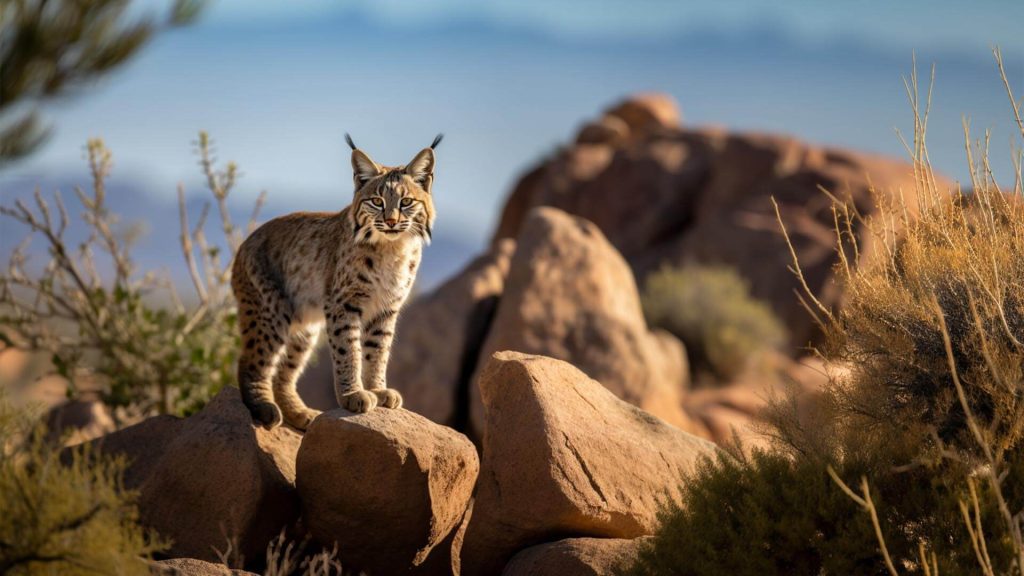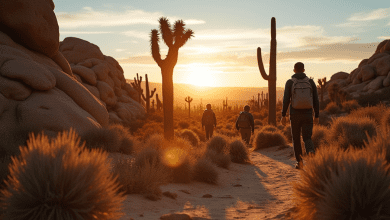Encountering a Bobcat in Joshua Tree National Park: Tips for a Safe Wilderness Encounter
What to do if you see a bobcat in Joshua Tree National Park

Joshua Tree National Park’s enchanting landscapes draw nature enthusiasts from far and wide. Amidst the majestic rock formations and towering Joshua trees, you may be fortunate enough to spot one of the park’s elusive inhabitants – the bobcat. This medium-sized wildcat, with its distinctive tufted ears and sleek coat, is a captivating sight.
However, if you happen to encounter a bobcat during your park exploration, it’s essential to know how to respond to ensure both your safety and the well-being of these magnificent creatures. Here are some valuable tips for a safe and memorable wilderness encounter with a bobcat in Joshua Tree National Park.
1. Remain Calm and Respectful
If you spot a bobcat while hiking or exploring the park, remain calm and refrain from panicking. These solitary and reclusive animals are generally shy and elusive, preferring to avoid human interaction. Give the bobcat plenty of space and observe from a safe distance, using binoculars or a camera with a zoom lens to admire its natural behavior without causing disturbance.
2. Keep Children and Pets Close
When exploring Joshua Tree National Park with children or pets, ensuring their safety and responsible behavior during a bobcat encounter is of utmost importance. The allure of encountering a wild bobcat amidst the rugged beauty of the park can be exhilarating, but it demands a delicate balance between embracing the wonder of wildlife and prioritizing safety. For children, engaging them in responsible wildlife observation teaches them about wildlife respect and the importance of observing from a safe distance. Encourage them to remain close and use binoculars or a camera’s zoom lens to appreciate these majestic creatures without encroaching on their space. Responsible pet ownership, including keeping pets on leashes, not only prevents unintended interactions but also ensures the safety of your furry companion. By prioritizing safety and respect during a bobcat encounter, we foster a harmonious coexistence with the park’s wildlife and contribute to the preservation of their natural behaviors.
3. Do Not Feed or Approach
Feeding wildlife, including bobcats, is strictly prohibited in national parks. Feeding disrupts natural behaviors and can lead to unhealthy dependence on human sources for food. Moreover, approaching a wild animal poses risks to both you and the animal. Maintain a respectful distance and observe without interfering.
4. Make Yourself Known
While maintaining a safe distance, let the bobcat know of your presence. Speak calmly and firmly or clap your hands to create noise. Most bobcats will instinctively avoid human encounters if they are aware of your presence.
READ: Surviving the Heat: Essential Safety Tips for Hiking in Joshua Tree National Park in Summer
5. Back Away Slowly
If the bobcat appears calm and is not showing any signs of aggression, you can slowly back away to increase the distance between you and the animal. Do not turn your back on the bobcat or run, as sudden movements may trigger its chase instinct.


6. Signs of Aggression
While bobcats are typically elusive and prefer to avoid human encounters, there are rare instances when they may exhibit signs of aggression if they feel threatened or cornered. Understanding these signs is crucial for ensuring a safe encounter for both you and the bobcat. Signs of aggression may include hissing, growling, or showing their teeth as a defensive mechanism to communicate that they are feeling threatened. In such situations, it is essential to remain calm and avoid any sudden movements that could escalate the situation. Backing away slowly while maintaining eye contact but without staring directly at the bobcat allows it to perceive that you are not a threat and gives it the necessary space to retreat to a more comfortable distance.
During such encounters, it’s essential to remember that the bobcat is not behaving aggressively out of malicious intent, but rather, it is trying to protect itself. As humans, we must respect the wild nature of these animals and refrain from provoking them further. Giving the bobcat ample space and allowing it to retreat to a safe distance is the most responsible and compassionate approach in these situations. By doing so, you minimize the potential for conflict and ensure the well-being of both yourself and the bobcat. Remember, bobcats are an integral part of Joshua Tree National Park’s ecosystem, and it is our duty to protect and preserve these beautiful creatures by maintaining a respectful and safe distance during any wildlife encounter.
7. Report Your Sighting
Help park authorities monitor wildlife activity by reporting your bobcat sighting to a park ranger or visitor center. Providing information about the encounter can contribute to research and conservation efforts.
Encountering a bobcat in Joshua Tree National Park can be a thrilling and memorable experience. By following these guidelines and respecting the natural behavior of these magnificent creatures, you can ensure a safe and harmonious encounter for both yourself and the bobcat. Embrace the opportunity to witness the beauty of Joshua Tree’s wildlife and continue to cherish the park’s ecological balance, preserving it for generations to come. Remember, observing wildlife in its natural habitat is a privilege – one that comes with the responsibility of protecting and respecting the animals that call this pristine wilderness home.



